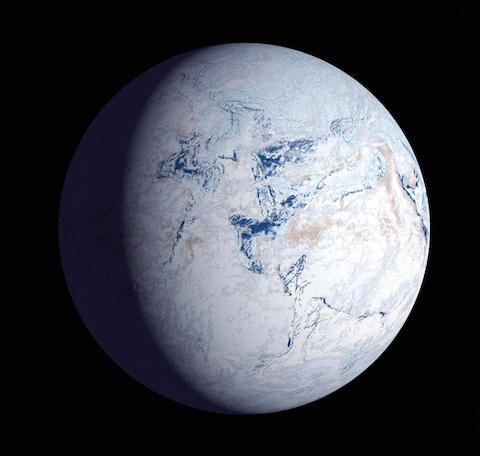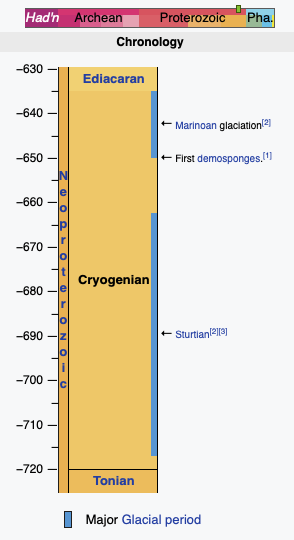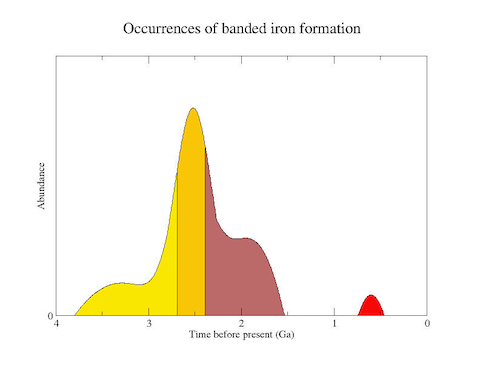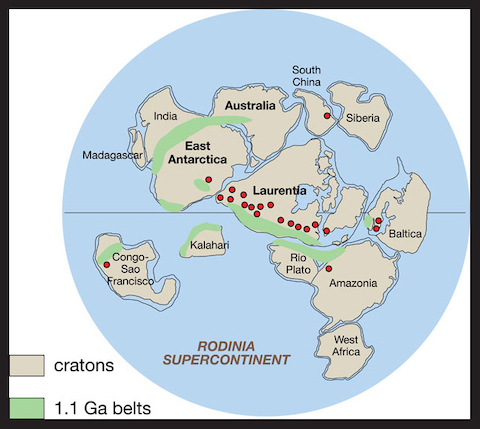
700 million years ago Earth froze over completely and stayed that way for millions of years.
How did this deep freeze start, and how did it end? We think it went like this:
At the time, all of Earth’s land was held in one large continent called Rodinia. As it began to break up, huge areas eroded, pulling carbon dioxide from the air and sequestering it in minerals.
With CO2 dropping, the atmosphere cooled, and ice began forming in the polar oceans. As the ice sheets extended, their white surfaces reflected sunlight, which amplified the cooling.
Soon the oceans were covered in ice, and Earth was frozen.
The average surface temperature dropped to negative 60 degrees Fahrenheit.
But beneath the ice, in what some believe to be the birth of plate tectonics, Earth was stirring.
Rodinia kept pulling apart. Volcanos formed along its rift zones and began pumping out carbon dioxide and water vapor.
Buildup of these greenhouse gases eventually drove runaway heating, which melted the glaciers.
In just a few hundred years, global average temperatures rocketed to more than 120 degrees.
The heat restarted the water cycle and drove weather systems that caused erosion, which consumed carbon dioxide. And Earth cooled again.
Thus began the constant cycling of Earth’s climate—and shortly thereafter, the explosion of life.
Background
Synopsis: More than 700 million years ago our blue planet froze from pole to pole, turning into a white Snowball Earth. Twice. The first lasted about 60 million years and the second lasted about 5 million years. Scientists have shown that rocks at the equator were ice covered during both of these Cryogenian ice ages and that runaway heating ended each. How did these extreme cycles start, and what caused them to end?
- About 100 million years before the expansion of multicellular life that occurred in the Cambrian Period, ice sheets covered Earth.
- We are living in the Phanerozoic Eon that began 541 million years ago when abundant complex lifeforms became common at the start of the Cambrian Period. Phanerozoic means “visible life” and includes the Paleozoic, Mesozoic and Cenozoic Eras.
- The time before this is called the Precambrian Eon, stretching back about 4 billion years further, eight times longer than the Phanerozoic.
- The Cryogenian Period is a part of the Precambrian that occurred from 720–635 million years ago during the Neoproterozoic Era.
- It wasn’t the first glacial episode on Earth, but it is thought to have been the most complete ice age, freezing Earth from pole to pole in two separate surges.
- The Sturtian lasted around 60 million years from around 720–660 million years ago and is documented in 39 places on 6 continents.
- The Marinoan lasted around 5 million years in the time frame of about 645–640 million years ago with 48 global locations.

The Cryogenian and its two ice ages are part of the late Proterozoic Eon. Credit: Wikimedia Commons
- After each of the ice ages, equatorial seas warmed rapidly, forming unique calcium carbonate caps that can only precipitate in warm water.
- It wasn’t the first glacial episode on Earth, but it is thought to have been the most complete ice age, freezing Earth from pole to pole in two separate surges.
- Rocks dated to these times show distinctive signs of glacial activity.
- Striations occur when a glacier gouges out a line in bedrock by dragging a cobble across it.
- Tillites form from ground up rock flour with pebbles and cobbles floating in it to produce a poorly sorted mixed-up rock.
- Dropstones form when floating ice melts, dropping pebbles and cobbles onto marine sediments, deforming the layering.
- Rhythmic iron-rich sedimentation demonstrates that the ocean waters were oxygen starved, smothered by the continuous thick ice sheets covering their surface.
- Banded iron deposits precipitated from waters enriched in iron sourced from hydrothermal vents on the seafloor, but the ferrous iron originally precipitated in these deposits can only form in the absence of oxygen.
- Outcrops of these unique rocks can be found in Namibia, Canada, and Brazil and represent the youngest banded iron formations on Earth.
- Older banded iron deposits can be found on ancient cratons from Greenland to Australia and range in age from 2–4 billion years old, before oxygen became plentiful on Earth.

This graph shows the relative abundance of banded iron formations in the geologic record as a function of time before the present. The highest abundance occurred 2.5 billion years ago and then disappeared from the geological record until the Cryogenian Snowball Earth period, shown in red. Credit: Kent G. Budge, via Wikimedia Commons - An amazing recent discovery demonstrates that the regular banding of these ancient deposits laid down on the ice-sheltered seafloor reflects the waxing and waning of glaciation related to the orbital periodicity of Milanković cycles (ED-215) that we observe today.
- Researchers have demonstrated that ice sheets covered the paleo equator.
- Some Cryogenian horizontally banded iron formations show magnetic inclination parallel to bedding.
- Earth’s magnetic field surges vertically out of the South Pole and dives vertically into the North Pole, changing direction with latitude.
- Magnetic field lines only parallel Earth’s surface at the equator, so magnetic inclination parallel to flat bedding only occurs at the equator.
- Rocks above and below these glacial units are tropical carbonates.
- Calcium carbonate rocks, like those found in the caps, can only precipitate in warm water, so finding glacial deposits interspersed with tropical deposits points to rapid swings of climate extremes.
- Some Cryogenian horizontally banded iron formations show magnetic inclination parallel to bedding.
- During the Neoproterozoic, all of Earth’s continents were assembled into one large continent, called Rodinia, straddling the equator, and researchers believe that its breakup during the Cryogenian Period set a series of climate extreme cycles in motion.
- Intensive weathering occurred on the equatorial supercontinent, eroding exposed rocks and producing ions that reacted readily with carbon dioxide in the atmosphere to produce carbonate rocks like limestone and dolomite.
- As the carbon dioxide was sucked out of the atmosphere and sequestered in minerals, the planet cooled and glaciation began in the polar oceans.
- Once ice sheets formed, the white surface albedo reflected sunlight to amplify cooling.

A proposed reconstruction of the Proterozoic supercontinent of Rodinia at 750 million years ago, just prior to its breakup. Credit: John Goodge, via Wikimedia Commons
- The average temperature on the planet’s surface during the Cryogenian Period has been estimated at -58oF (-50oC).
- With the oceans covered in ice, water couldn’t evaporate to drive the water cycle to produce precipitation.
- Without precipitation to feed the glaciers, some scientists wonder how they could continue to move. Imagine a slushball Earth with some open water at the equator.
- Meanwhile, while Earth was cloaked in ice, the internal machinery of the planet continued to move.
- Recent research synthesis suggests this episode may have marked the onset of plate tectonics on Earth.
- Rodinia’s rift zone volcanos were continuously pumping carbon dioxide and water vapor into the atmosphere.
- Buildup of these greenhouse gases eventually drove runaway heating that ended the glaciation very rapidly, with researchers estimating that global average temperatures rose to 122oF (50oC) in just a few hundred years.
- The heat restarted the water cycle and drove weather systems that led to increased erosion, yielding reactive ions that consumed carbon dioxide, sequestering it in rocks and cooling Earth again.
- The first time this cycle occurred after the longer Sturtian glaciation the cooling drove a second shorter Marinoan ice age about 10–20 million years later.
- When the Marinoan ice age ended, rapid warming was followed by cooling again, culminating in the short lived and less extensive Ediacaran Gaskiers glaciation about 40 million years later, which was just 340,000 years in duration.
- The Ediacaran Period ushered in the first fossil animals preserved in Earth’s geological record, foreshadowing the Cambrian explosion of life and continuing the constant cycling of Earth’s surface we know as plate tectonics.

